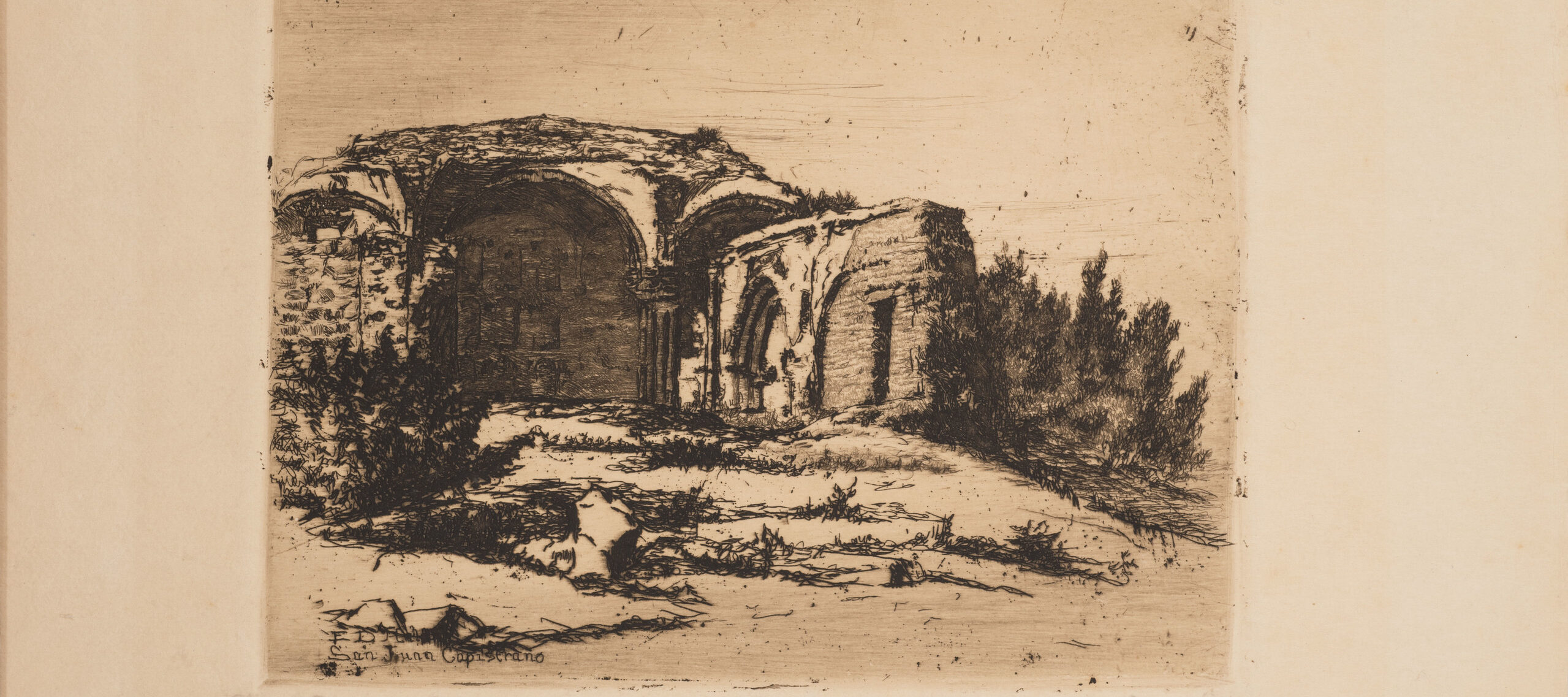WASHINGTON—The National Museum of Women in the Arts (NMWA) presents Wanderer: Travel Prints by Ellen Day Hale, Oct. 4, 2013 through Jan. 5, 2014. The exhibition features approximately 25 etchings by American artist Ellen Day Hale (1855–1940) as well as materials she used for the full printing process, including printing plates, transfer drawings and painted studies. Hale rose to prominence as a member of the Boston School of painting, a style influenced by French Impressionist and Barbizon painters, featuring vibrant color and mastery of light. Though renowned for her bold portrait paintings, Hale also played an active role in reviving the etching printmaking technique at the turn of the 20th century. After pursuing art training in Paris, Hale traveled extensively through Europe, the Middle East and America. The artist’s evocative landscape prints demonstrate a more contemplative mood than her bold painted portraits, which in 1887 earned a reviewer’s backhanded compliment of “display[ing] a man’s strength.” Drawn from NMWA’s collection, Wanderer: Travel Prints by Ellen Day Hale presents the artist’s intricately detailed etchings of the cities, landscapes and people that she encountered on her journeys.
Born in Worcester, Massachusetts, Hale displayed an early interest in drawing and was likely first taught by her aunt Susan Hale, a successful watercolorist and advocate for the advancement of women in the arts. Hale’s other accomplished family members included her father, Edward Everett Hale, an author and chaplain of the United States Senate, and her great-aunt Harriet Beecher Stowe, author of Uncle Tom’s Cabin.
Hale received formal art training from Boston sculptor William Rimmer before moving on to drawing and painting classes taught by William Morris Hunt. Rimmer and Hunt were exceptional for their commitment to women’s education. Hale also attended classes at the Pennsylvania Academy of the Fine Arts before embarking on her first trip to Europe, a journey that spurred a lifetime of travel and significantly influenced her as an artist.
On her first journey in 1881–82, Hale traveled to France, Belgium, Holland, Italy and Spain. She spent the majority of her time in France, studying in Paris in the ateliers of Emile-Auguste Carolus-Duran and Jean-Jacques Henner. She also took formal classes at the Jardin des Plantes, the Académie Colarossi and the Académie Julian.
In 1883 Hale returned to the U.S. for two years; during this time she met Gabrielle de Veaux Clements, an artist from Philadelphia who became her lifelong companion and taught her printmaking techniques. Learning to etch enabled Hale to work on an intimate scale, and she used this process to document her extensive travels. Hale’s landscape prints reflect the strong popularity at the turn of the last century of romantic images of faraway locales.
The etching technique was developed during the Renaissance, but it fell out of favor as other printmaking techniques, including lithography, evolved. In the mid-19th century, etching experienced a revival as artists objected to the proliferation of precise, mechanically reproduced illustrations in books and magazines. Hale mastered the etching process, which involves coating a metal plate with an acid-resistant layer through which the artist cuts an image. The plate is immersed in an acid bath, which “bites” the exposed metal, creating depressions in the printing plate.
In 1885, after returning to Paris, Hale wrote about her experiences for the newspaper Boston Traveller, encouraging female artists to travel abroad. She continued her own travels, venturing to California in the early 1890s. She produced a number of etchings of former Spanish missions, including San Juan Capistrano (c. 1893). Her etching of the mission, which was abandoned at the time, captures the ruins of the Great Stone Church amid the rugged Western landscape.
Hale returned to Massachusetts in 1893. However, she continued to travel throughout the rest of her life, touring Europe in 1895, traveling through France and Sicily in 1921–22, and visiting Egypt, Syria and Palestine in 1929. This trip inspired Milk Delivery, Cairo (1930). Hale also traveled throughout the U.S., visiting Colorado, Nevada, Arizona and South Carolina.
National Museum of Women in the Arts
Founded in 1981 and opened in 1987, NMWA is the only museum solely dedicated to celebrating the achievements of women in the visual, performing and literary arts. The museum’s collection features 4,500 works from the 16th century to the present created by more than 1,000 artists, including Mary Cassatt, Frida Kahlo, Alma Thomas, Lee Krasner, Louise Bourgeois, Chakaia Booker and Nan Goldin, along with special collections of 18th-century silver tableware and botanical prints. NMWA is located at 1250 New York Avenue, NW, Washington, D.C., in a landmark building near the White House. It is open Monday–Saturday, 10 a.m.–5 p.m. and Sunday, noon–5 p.m. For information, call 202-783-5000 or visit www.nmwa.org. Admission is $10 for adults, $8 for visitors 65 and over and students, and free for NMWA Members and youths 18 and under. Free Community Days are on the first Sunday of the month. For more information about NMWA, visit www.nmwa.org, Broad Strokes Blog, Facebook or Twitter.

